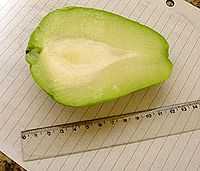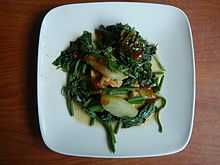Chayote
| Chayote | |
|---|---|
 | |
| Chouchous on sale in Réunion Island | |
| Scientific classification | |
| Kingdom: | Plantae |
| (unranked): | Angiosperms |
| (unranked): | Eudicots |
| (unranked): | Rosids |
| Order: | Cucurbitales |
| Family: | Cucurbitaceae |
| Genus: | Sechium |
| Species: | S. edule |
| Binomial name | |
| Sechium edule (Jacq.) Sw. | |
| Synonyms[1] | |
| Nutritional value per 100 g (3.5 oz) | |
|---|---|
| Energy | 80 kJ (19 kcal) |
| Carbohydrates | 4.51 g |
| - Sugars | 1.66 g |
| - Dietary fiber | 1.7 g |
| Fat | 0.13 g |
| Protein | 0.82 g |
| Thiamine (vit. B1) | 0.025 mg (2%) |
| Riboflavin (vit. B2) | 0.029 mg (2%) |
| Niacin (vit. B3) | 0.47 mg (3%) |
| Pantothenic acid (B5) | 0.249 mg (5%) |
| Vitamin B6 | 0.076 mg (6%) |
| Folate (vit. B9) | 93 μg (23%) |
| Vitamin C | 7.7 mg (9%) |
| Vitamin E | 0.12 mg (1%) |
| Vitamin K | 4.1 μg (4%) |
| Calcium | 17 mg (2%) |
| Iron | 0.34 mg (3%) |
| Magnesium | 12 mg (3%) |
| Phosphorus | 18 mg (3%) |
| Potassium | 125 mg (3%) |
| Zinc | 0.74 mg (8%) |
| Link to USDA Database entry Percentages are roughly approximated using US recommendations for adults. Source: USDA Nutrient Database | |
Chayote[1] (Sechium edule), also known as christophene or christophine,[1] cho-cho,[1] mirliton[2] or merleton (Creole/Cajun), chuchu (Brazil), Cidra (Antioquia, Caldas, Quindio and Risaralda regions of Colombia), Guatila (Boyacá and Valle del Cauca regions of Colombia), Centinarja (Malta), Pipinola (Hawaii), pear squash, vegetable pear,[1] chouchoute, choko, güisquil (El Salvador),[3] Labu Siam (Indonesia), Ishkus (Darjeeling, India), Sayote (Philippines)[4] is an edible plant belonging to the gourd family Cucurbitaceae, along with melons, cucumbers and squash.
Chayote is originally native to Mexico or Central America where it grows abundantly and has little commercial value, and it has been introduced as a crop all over Latin America, and worldwide. The main growing regions are Brazil, Costa Rica and Veracruz, Mexico. Costa Rican chayotes are predominantly exported to the European Union, whereas Veracruz is the main exporter of chayotes to the United States.
The word chayote is a Spanish derivative of the Nahuatl word chayohtli (pronounced [t͡ʃaˈjoʔt͡ɬi]). Chayote was one of the many foods introduced to Europe by early explorers, who brought back a wide assortment of botanical samples. The Age of Conquest also spread the plant south from Mexico, ultimately causing it to be integrated into the cuisine of many other Latin American nations.
The chayote fruit is used in mostly cooked forms. When cooked, chayote is usually handled like summer squash, it is generally lightly cooked to retain the crisp flavor. Though rare and often regarded as especially unpalatable and tough in texture, raw chayote may be added to salads or salsas, most often marinated with lemon or lime juice. Whether raw or cooked, chayote is a good source of amino acids and vitamin C.
Although most people are familiar only with the fruit as being edible, the root, stem, seeds and leaves are as well. The tubers of the plant are eaten like potatoes and other root vegetables, while the shoots and leaves are often consumed in salads and stir fries, especially in Asia. Like other members of the gourd family, such as cucumbers, melons, and squash, chayote has a sprawling habit, and it should only be planted if there is plenty of room in the garden. The roots are also highly susceptible to rot, especially in containers, and the plant in general is finicky to grow. However, in Australia and New Zealand, it is an easily grown yard or garden plant, set on a chicken wire support or strung against a fence.
Taxonomy
The plant was first recorded by modern botanists in P. Browne's 1756 work, the Civil and Natural History of Jamaica.[5] In 1763, it was classified by Jacquin as Sicyos edulis and by Adanson as Chocho edulis.[citation needed] Swartz included it in 1800 in its current genus Sechium.
Description

In the most common variety, the fruit is roughly pear-shaped, somewhat flattened and with coarse wrinkles, ranging from 10 to 20 cm in length. It looks like a green pear, and it has a thin, green skin fused with the green to white flesh, and a single, large, flattened pit. Some varieties have spiny fruits. The flesh has a fairly bland taste, and a texture is described as a cross between a potato and a cucumber. Although generally discarded, the seed has a nutty flavor[citation needed] and may be eaten as part of the fruit.
The chayote vine can be grown on the ground, but as a climbing plant, it will grow onto anything, and can easily rise as high as 12 meters when support is provided. It has heart-shaped leaves, 10–25 cm wide and tendrils on the stem. The plant bears male flowers in clusters and solitary female flowers.[6] The plant’s fruit is light green and elongated with deep ridges lengthwise.
Culinary and medicinal uses


The fruit does not need to be peeled to be cooked or fried in slices. Most people regard it as having a very mild flavor by itself (though some find it unpalatable). It is commonly served with seasonings (e.g. salt, butter and pepper in Australia) or in a dish with other vegetables and/or flavorings. It can also be boiled, stuffed, mashed, baked, fried, or pickled in escabeche sauce. Both fruit and seed are rich in amino acids and vitamin C.[7] Fresh green fruit are firm and without brown spots or signs of sprouting. Smaller ones are more tender.
The tuberous part of the root is starchy and eaten like a yam (can be fried). It can be used as pig or cattle fodder, as well.
The leaves and fruit have diuretic, cardiovascular and anti-inflammatory properties, and a tea made from the leaves has been used in the treatment of arteriosclerosis and hypertension, and to dissolve kidney stones.[7]
In Louisiana Creole and Cajun cuisine, the fruit, known as mirliton (pronounced IPA: [ˈmɜːlɪtɒn])[8] also spelled mirletons or merletons (plural—the r is often silent, e.g. Cajun me-lay-taw or urban Creole miʁl-uh-tɔ̃ns)[2] is a popular seasonal dish for the holidays, especially around Thanksgiving, in a variety of recipes.
Chayote is an important part of traditional diets across Mesoamerica, and can be found in a variety of dishes.

In the Philippines, the plant is known as "Sayote" and is grown mostly on Mountainous part of the country such as Baguio City and parts of Cordillera Administrative Region. Chayote is used in many kinds of dishes such as soup, stir-fried vegetables and chop suey.
In Indonesia, chayotes are called labu siam and widely planted for their shoots and fruit. It's generally used in Sundanese food as "lalap" and one of ingredients for Sundanese cuisine called "sayur asem".
In Taiwan, chayotes are widely planted for their shoots, known as lóng xü cài (龍鬚菜, literally "dragon-whisker vegetable"). Along with the young leaves, the shoot is a commonly consumed vegetable in the region.
In Thai cuisine, the plant is known as sayongte (Thai: ซายองเต้) or fak maeo (Thai: ฟักแม้ว, literally meaning "Miao melon"). It grows mainly in the mountains of northern Thailand. The young shoots and greens are often eaten stir-fried or in certain soups.
In Brazil and other Latin American countries, it is breaded and fried, or used cooked in salads, soups and soufflés.
In Darjeeling, India and Nepal, the plant and fruit is called ishkus (इस्कुस in Nepali), probably derived from the word squash. Its shoots, fruit and roots are widely used for different varieties of curries.
Chayote is also popular in South Indian cuisine. It is popularly referred to as "Bangalore brinjal (Bengaluru vankayya)", called in Kannada as "seeme badanekai" - brinjal/eggplant/aubergine of the plateau. It is used in vegetable stews like "sambar" and "palya".
In Tamil Nadu in South India, it is known as "chow chow" and widely used in everyday cooking for "sambar" or "kootu". In Andhra Pradesh, it is called Bengaluru vankayya and sold in vegetable markets in the name of "chow chow".
Folklore
- "Apple pie"
In Australia, where it is called choko, a persistent rumour is that McDonald's apple pies were made of chokos, not apples. This eventually led McDonald's to emphasise the fact that real apples are used in their pies. This legend was based on an earlier belief that tinned pears were often disguised chokos. A possible explanation for the rumour is that there are a number of recipes in Australia that advise chokos can be used in part replacement of canned apples to make the fruit go farther in making apple pies. This likely arose because of the economies of "mock" food substitutes during the Depression Era,[9] shortages of canned fruit in the years following World War II, and the fact apples do not grow in many tropical and subtropical parts of Australia, making them scarce. Chokos, on the other hand, grow extensively in Australia, with many suburban backyards featuring choko vines growing along their fence lines.
Another possible reason for the rumour of McDonald's apple pies containing chokos was that it was thought that apples would degenerate and become soggy and inedible in a McDonald's pie, whereas chokos are well known to retain their firmness and consistency after cooking, freezing, and reheating. It was thought that the "chunks" of apple in the pie were in fact chunks of choko, and the sauce and filling were simply a spiced, apple-flavoured concoction.
- Mummies
Due to its purported cell-regenerative properties, it is believed as a contemporary legend that this fruit caused the mummification of people from the Colombian town of San Bernardo who extensively consumed it. The very well preserved skin and flesh can be seen in the mummies today.[citation needed]
Gallery
-

Perulero (yellowish-white variety)
-
Sprouting chayote, showing reproductive process of this plant
-

Chayote growing on vines
-

Chayote on vines
-

Chayote Plantation
-
Sechium edule (chayote) with beef (Philippines).
See also
- Araujia sericifera, a toxic weed that is often described as "choko-like".
- List of vegetables
References
- ↑ 1.0 1.1 1.2 1.3 1.4 "USDA GRIN Taxonomy".
- ↑ 2.0 2.1 "Mirlitons". Cooking Louisiana.
- ↑ Meza, Joaquín. Real Diccionario de la Vulgar Lengua Guanaca. Nekepú Editores, San Salvador,El Salvador. 2008. ISBN 978-99923-70-60-5. p. 279
- ↑ Stuart, Dr. Godofredo. "Sayote". Philippines medicinal plants. Stuart Exchange. Retrieved 14 January 2014.
- ↑ Browne, Patrick (1756), Civil and Natural History of Jamaica, retrieved 2007-03-19
- ↑ Grubben, G.J.H. (2004). Plant resources of tropical Africa: Vegetables. Backhuys. ISBN 978-90-5782-147-9.
- ↑ 7.0 7.1 Rafael Lira Saade. 1996 p.29
- ↑ "mirliton". Collins English Dictionary - Complete & Unabridged (11th. ed.). Retrieved 31 August 2012.
- ↑ Mindfood Magazine, Food From the Source: "Secret Ingredient: the Outcast" article by Laura Venuto, Nov 19, 2010
Sources
- Rafael Lira Saade. 1996. Chayote Sechium edule (Jacq.) Sw. Promoting the conservation and use of underutilized and neglected crops. 8. Institute of Plant Genetics and Crop Plant Research, Gatersleben/International Plant Genetic Resources Institute, Rome, Italy. ISBN 92-9043-298-5 available in pdf format
External links
| Wikimedia Commons has media related to Chayote. |
- Mirlitons.org Nonprofit organization dedicated to promoting the conservation and innovative uses of Louisiana heirloom mirlitons - includes free growing guides and recipes.
- Adopt a Mirliton Nonprofit Program
- Chayote Information Purdue University Horticulture
- Growing Chayote Mother Earth News

